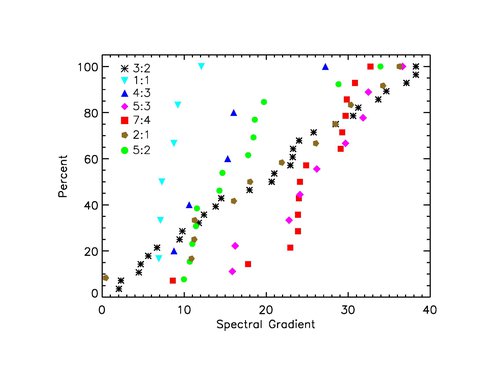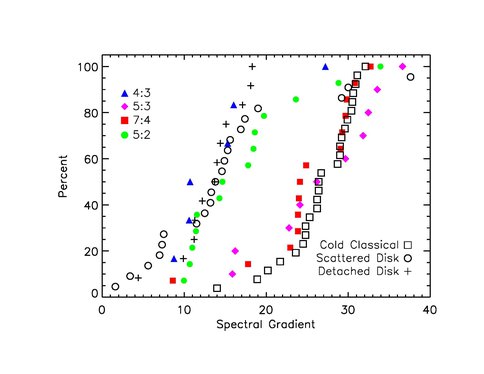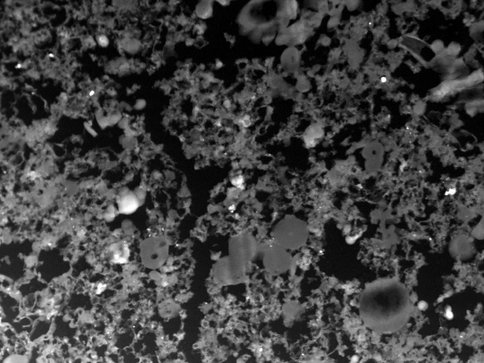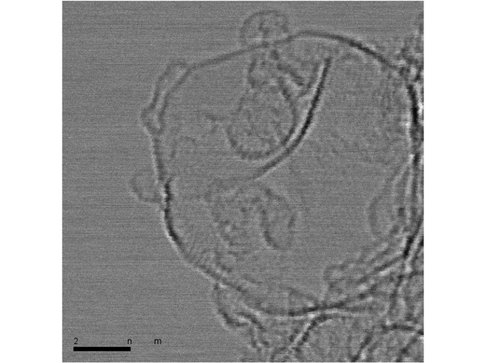2012 Annual Science Report
 Carnegie Institution of Washington
Reporting | SEP 2011 – AUG 2012
Carnegie Institution of Washington
Reporting | SEP 2011 – AUG 2012
Project 2: Origin and Evolution of Organic Matter in the Solar System
Project Summary
Extraterrestrial organic matter as is found in comets and certain meteorites has the potential to tell us much about the origin of the solar system, the origin of planetary volatiles, and possible the origins of life. In this project, we bring a powerful array of analytical methods to bare on understanding extraterrestrial organic matter at the molecular level. Our work links astronomy, chemistry, physics, and planetary science.
Project Progress
Project 2: The Origin and Evolution of Organic Matter in the Solar System
2.1. The Outer Solar System
We have continued observations, led by Co-Investigator Scott Sheppard, of bodies in the outer Solar System. We measured the optical colors of 58 outer Solar System objects in mean motion resonance with Neptune (Sheppard 2012). We found that the various Neptune resonant populations have significantly different surface color distributions. This indicates vastly different origins and evolutions for the objects in resonance with Neptune. The 5:3 and 7:4 resonances have semi-major axes near the middle of the main Kuiper Belt and both are dominated by ultra-red material (spectral gradient: S>25). The 5:3 and 7:4 resonances have statistically the same color distribution as the low inclination Cold Classical belt. Ultra-red colors are likely created from material rich in very volatile ices and organics, and is mostly only seen on objects that have always remained far from the Sun. This material is rare and may be a source of the volatiles and organics found on Earth from scattering during the chaos in the early Solar System. Were the ultra-red objects emplaced into the Kuiper Belt or did they form in situ? One of the simplest ways to try and answer this question is to catalog the current locations of ultra-red objects. As most stable ultra-red objects appear to be in low inclination orbits within the heart of the main Kuiper Belt, it appears this material formed in situ.
The inner 4:3 and distant 5:2 Neptune resonances have objects with mostly moderately red colors (S~15), similar to the scattered and detached disk populations, which likely supply most of the short-period comets. The 2:1 resonance, which is near the outer edge of the main Kuiper Belt, and the 3:2, which is near the inner edge, have a large range of colors with similar numbers of neutral, moderately red and ultra-red objects at all inclinations. This indicates that these two resonances likely captured objects that formed in many different places within the Solar System. The Neptune Trojans (1:1 resonance) are only slightly red (S~9), similar to the Jupiter Trojans. The different color distributions of objects in mean motion resonance with Neptune are likely a result of the disruption of the primordial Kuiper Belt by migration of the giant planets.
In addition to the above resonant color observations, we also discovered and analyzed the first ultra-red, equal-sized binary known outside of the Cold Classical Kuiper Belt. Numerical simulations suggest 2007 TY430’s current heliocentric orbit is moderately unstable in the outer part of the 3:2 Neptune resonance. Thus, 2007 TY430 is likely an escaped Cold Classical object that later got trapped in the 3:2 resonance. Similar to the known equal-sized, wide binaries in the Cold Classical population, the binary 2007 TY430 requires a high albedo and very low density structure to obtain the total mass found for the pair. For a realistic minimum density of 0.5 g/cm3, the albedo of 2007 TY430 would be greater than 0.17. For reasonable densities, the radii of either component should be less than 60 km, and thus the relatively low eccentricity of the binary is interesting since no tides should be operating on the bodies at their large distances from each other. The low prograde inclination of the binary also makes it unlikely that the Kozai mechanism could have altered the orbit, making the 2007 TY430 binary orbit likely one of the few relatively unaltered primordial binary orbits known.
Equal-sized, wide binaries and ultra-red colors are common in the low inclination Cold Classical part of the Kuiper Belt and likely formed through some sort of three body interactions within a much denser Kuiper Belt. These equal-sized, wide binaries are not likely to form in the current low density Kuiper Belt we see today. Further analysis of the orbit well help us understand the dynamical escape pathways from the Cold Classical region to other regions in the Solar System in order to understand how the ultra-red material has been distributed over the Solar System.
2.2. Organics in Meteorites
Co-Is Nittler, Alexander, Stroud, and Cody have continued their coordinated multi-technique microanalytical studies of meteoritic organic matter, both in situ and as isolated insoluble organic matter (IOM) residues. Last year, we reported the discovery and detailed isotopic, mineralogical and chemical investigation of a large – 8 × 6 μm – carbonaceous inclusion in the primitive CR3 chondrite QUE 99177. This year, we have extended this research to several more micron-sized C inclusions in this meteorite and CR2 GRA 95229 (Fig. 3). After they are identified by mapping of polished meteorite sections by either SEM-EDS or NanoSIMS, ultra-thin sections of the inclusions are extracted by focused ion beam (FIB) and analyzed by STXM, TEM and NanoSIMS. Our results indicate that there is a diversity in the properties of C inclusions in primitive meteorites. For example, some inclusions appear to be isotopically and chemically homogeneous aggregates of nanoglobules, tiny hollow carbonaceous spheres, whereas others show isotopic heterogeneity and/or a smoother morphology. XANES analysis has revealed that the large inclusions typically show X-ray absorptions attributable to imine and nitrile functionality, features absent from both chemically extracted IOM and sub-micron inclusions measured in situ. These observations may indicate that an original 15N- and nitrile-enriched material is preferentially protected against parent-body processing in larger carbonaceous inclusions.
Co-I Stroud and postdoctoral fellow Hitesh Changela continued transmission electron microscopy studies of the morphologies of insoluble organic matter (IOM) residues from two classes of carbonaceous chondrites. The goal of this work was to identify any correlation of the IOM morphology with meteorite class or petrographic grade. Annual dark-field scanning transmission electron micrographs from representative areas of IOM residues were obtained for 4 CM and 4 CR meteorites of varying levels of hydrothermal alteration. All IOM residues showed three main morphologies: fluffy, i.e. porous at a 50 nm or smaller scale; globular, i.e., discrete round blebs with or without a central void; and dense irregular, i.e., non-porous, non-circular blebs. The fluffy morphology accounted for >90 % area-fraction of the IOM from each sample, and the globules accounted from 4 % to 7%. Quantitative comparison of the fluffy material within each meteorite class also revealed a coarsening in texture, i.e., increase in mean features size and loss of fine-scale porosity, with increasing levels of aqueous alteration. This suggests that aqueous fluids on the parent body are responsible for physical transport of the IOM components. For CR IOM samples, which all have bulk enrichments in 15N ranging from δ15N of +162 ‰ to +233 ‰, we observed a correlation of the area fraction of nanglobules with the bulk N isotopic composition. Prior isotope measurements indicate that the nanoglobules are not the dominant carrier of the 15N, and that not all globules are 15N rich. Thus, this correlation of total nanoglobule abundance with bulk N isotope composition most likely reflects a common underlying process for loss of 15N and conversion of nanoglubles to other forms of carbonaceous matter. This correlation does not hold for the CM samples, which are more heavily altered, and have bulk δ15N values from -8.5 ‰ to +5.9 ‰.
This year we also began a new collaboration with Sachiko Amari at Washington University to investigate the structure of carbonaceous residues from the Saratov (L4) ordinary chondrite. Residues prepared by Dr. Amari have the highest concentration of Q gases of any known chondritic material. The carrier of the Q gases, i.e., remnant noble gases from the early Solar System with a specific elemental fractionation compared to solar composition, has eluded identification for over thirty years. The Saratov samples offer the best chance of identification of the primary carrier, because extensive thermal metamorphism on the Saratov parent body has oxidized presolar diamond and SiC, which host modest levels of Q gases. Electron microscopy studies of the Saratov residues carried out by Stroud demonstrate that only phase of carbon present in these residues in porous nanoscale graphene, similar to activated carbon. Nanoscale graphene has previously been identified in the interiors of graphite grains that condensed in the circumstellar envelopes of AGB stars prior to the formation of the Sun. However, thermal metamorphism of other carbonaceous phases could produce similar material, and multiple origins for the Saratov residue phase are probable. Single-atom sensitivity STEM images, of the residues obtained by Stroud at Oak Ridge National Lab, show that the graphene occurs as irregular platelets of 2 nm to 50 nm diameter, and that the edges are frequently curled into closed tubes. The trapping sites of the noble gas atoms in the porous graphene have not yet been identified, due to the low gas atom concentration. The STEM images reveal many possible sites, including inside the curled edges of the graphene, at pores between graphene platelets, or possibly even incorporated into the graphene planes, at UV-radiation induced defect sites. Additional microscopy studies are planned to look for segregation of Q gases to specific sites.
2.3. Origin of asteroids and volatiles in the terrestrial planets
Co-Is Alexander, Fogel and Nittler presented and published their work on the origin of the volatiles in chondrites, and the implications this has for the relationship between asteroids and comets, as well as the origin of volatiles (H, C and N) on Earth and the other terrestrial planets. Determining the source(s) of H, C and N accreted by Earth is important for understanding the origins of water and life, and for constraining dynamical processes that operated during planet formation. Chondritic meteorites are asteroidal fragments that retain records of the first few million years of Solar System history. Recent dynamical models of the orbital evolution of planets and planetesimals suggest that many asteroids, particularly those that are thought to be the parent bodies of the carbonaceous chondrites, formed well beyond the orbit of Jupiter and possibly as far out as the source regions of comets. These dynamical models also suggest that these icy, outer Solar System bodies could have been the main sources of volatiles for the forming terrestrial planets. D/H ratios of water are expected to increase with increasing radial distance from the Sun. The D/H ratios of the ices of several comets have now been measured and, as expected, are considerably enriched relative to the protosolar composition. The same is true for Saturn’s moon Enceladus. We showed that the D/H ratios of water in carbonaceous chondrites are lower than those in comets and Enceladus, implying that the chondrites formed in a different region of the Solar System, probably much closer to the Sun, contrary to the predictions of recent dynamical models. The D/H ratios of water in carbonaceous chondrites also argue against an influx of water ice from the outer Solar System that has been invoked to explain the non-solar oxygen isotopic composition of the inner Solar System. Finally, we argued that the bulk H and N isotopic compositions of CI chondrites suggest that they were the principal source of the Earth’s volatiles.
2.4. Understanding the origin and evolution of D/H abundances in Extraterrestrial Organic solids
Co-Is Cody, Alexander and Fogel along with Post Doctoral Fellows Wang and Kebukawa have continued their study of intramolecular D/H fractionation in chondritic organic solids using Solid State Nuclear Magnetic Resonance (NMR) spectroscopy. We have developed an NMR experiment that allows us collect isotropic D-NMR spectra that allow for direct comparison with H-NMR spectra enabling us to investigate intramolecular D/H speciation in complex chondritic organic solids. This work was presented at the 2012 AbSciCon conference in Atlanta, Ga. We have continued our studies of interstellar formaldehyde as a potential precursor to refractory organic solids in both chondrites and comets. Our first paper on this work was published in PNAS early during this funding cycle. We have submitted a second expanded paper on this subject to the Astrophysical Journal. Finally we have focused on the kinetics of D/H isotope exchange in chondritic organic solids using the formaldehyde polymer to place constraints on initial D/H abundances in cometary and chondritic organic solids and possible the terrestrial planets. A paper on this work is in preparation.
The Kolmogorov-Smirnov test (K-S test) plotted for the Neptune Trojans 1:1 (cyan upside down triangles), 4:3 (blue triangles), 5:3 (purple diamonds), 7:4 (red squares), 2:1 (brown pentagons), 5:2 (green circles) and 3:2 (black asterisks). The vertical axis shows the cumulative spectral gradient, S, for the objects, where ultra-red is S>25. The Neptune Trojans (1:1) are the most neutral in color and uniform of all the resonances. The 4:3 and 5:2 are mostly only moderately red in color. The 5:3 and 7:4 resonance objects are mostly ultra-red. The 2:1 and 3:2 resonances seem to have a mix of all object colors.
Detached Disk (pluses), and Cold Classical Kuiper Belt objects (open squares) are shown to compare to the 4:3, 5:3, 7:4 and 5:2 resonances. The 1:1, 3:2 and 2:1 resonances have been removed for clarity. The 4:3 and 5:2 resonances appear to be very similar in color distribution as the scattered disk and detached disk objects while the ultra-red dominated 5:3 and 7:4 resonant populations are very similar in color distribution to the Cold Classical Kuiper belt.
Coordinated analysis of FIB section of GRA 95229 carbonaceous chondrite. A) Bright-field TEM image. The large bright feature is an iron sulfide grain, while large C concentrations appear dark. B) NanoSIMS 15N/14N ratio map of section indicating that C vein is largely homogeneously enriched in 15N. C) STXM C-edge absorption map of section; outlines indicate C-rich regions for which C-XANES spectra are shown in D).
Dark-field STEM image of insoluble organic matter from the meteorite GRO 9557 (CR1). The width of the image is ~ 3 micrometers. Most of the organic matter is nanoporous or “fluffy”. Compact, round blebs, termed nanoglobules, and dense, irregularly shape matter is also present.
Bright-field STEM showing the nanoscale porous graphene structure of the phase-Q-rich residue from the Saratov meteorite.
Publications
-
Alexander, C. M. O., Bowden, R., Fogel, M. L., Howard, K. T., Herd, C. D. K., & Nittler, L. R. (2012). The Provenances of Asteroids, and Their Contributions to the Volatile Inventories of the Terrestrial Planets. Science, 337(6095), 721–723. doi:10.1126/science.1223474
-
Cody, G. D., Heying, E., Alexander, C. M. O., Nittler, L. R., Kilcoyne, A. L. D., Sandford, S. A., & Stroud, R. M. (2011). Establishing a molecular relationship between chondritic and cometary organic solids. Proceedings of the National Academy of Sciences, 108(48), 19171–19176. doi:10.1073/pnas.1015913108
-
De GREGORIO, B. T., Stroud, R. M., Cody, G. D., Nittler, L. R., David Kilcoyne, A. L., & Wirick, S. (2011). Correlated microanalysis of cometary organic grains returned by Stardust. Meteoritics & Planetary Science, 46(9), 1376–1396. doi:10.1111/j.1945-5100.2011.01237.x
-
Herd, C. D. K., Blinova, A., Simkus, D. N., Huang, Y., Tarozo, R., Alexander, C. M. O., … Stroud, R. M. (2011). Origin and Evolution of Prebiotic Organic Matter As Inferred from the Tagish Lake Meteorite. Science, 332(6035), 1304–1307. doi:10.1126/science.1203290
-
Kebukawa, Y., Alexander, C. M. O. D., & Cody, G. D. (2011). Compositional diversity in insoluble organic matter in type 1, 2 and 3 chondrites as detected by infrared spectroscopy. Geochimica et Cosmochimica Acta, 75(12), 3530–3541. doi:10.1016/j.gca.2011.03.037
-
Nuevo, M., Milam, S. N., Sandford, S. A., De Gregorio, B. T., Cody, G. D., & Kilcoyne, A. L. D. (2011). XANES analysis of organic residues produced from the UV irradiation of astrophysical ice analogs. Advances in Space Research, 48(6), 1126–1135. doi:10.1016/j.asr.2011.05.020
-
Sheppard, S. S. (2012). THE COLOR DIFFERENCES OF KUIPER BELT OBJECTS IN RESONANCE WITH NEPTUNE. The Astronomical Journal, 144(6), 169. doi:10.1088/0004-6256/144/6/169
-
Sheppard, S. S., Ragozzine, D., & Trujillo, C. (2012). 2007 TY430: A COLD CLASSICAL KUIPER BELT TYPE BINARY IN THE PLUTINO POPULATION. The Astronomical Journal, 143(3), 58. doi:10.1088/0004-6256/143/3/58
-
Trujillo, C. A., Sheppard, S. S., & Schaller, E. L. (2011). A PHOTOMETRIC SYSTEM FOR DETECTION OF WATER AND METHANE ICES ON KUIPER BELT OBJECTS. The Astrophysical Journal, 730(2), 105. doi:10.1088/0004-637x/730/2/105
- Alexander, C.M.O.D., Bowden, R., Fogel, M.L., Howard, K. & Herd, C.D.K. (2012). The origin of water in chondrites and volatiles in the terrestrial planet region. Lunar and Planetary Science, 43: #1929.
- Changela, H.G., Stroud, R.M., De Gregorio, B.T., Nittler, L.R. & Alexander, C.M.O.D. (2011). Nanoglobule abundances in IOM extracts: correlation with parent body processing. Meteoritics & Planetary Science (Supp.), Abstract #5504.
- Moskovitz, N.A., Yang, B., Lim, L.F., Willman, M., Rivkin, A.S., Emery, J.P., Granvik, M. & Sheppard, S.S. (2012). The Near-Earth encounter of 2005 YU55: Time-resolved visible and near-infrared spectroscopy. Asteroids, Comets and Meteorrs.
- Peeters, Z., Alexander, C.M.O.D., Changela, H., Nittler, L.R., Price, S. & Stroud, R.M. (2011). In situ synchrotron X-ray transmission microscopy of CR chondrites QUE 991777 and GRA 95229. Meteoritics and Planetary Science (Supp.), Abstract #5476.
- Peeters, Z., Changela, H., Stroud, R.H., Alexander, C.M.O.D. & Nittler, L.R. (2012). Organic Carbon Inclusions in CR2 Chondrite Graves Nunataks 95229. Meteoritics and Planetary Science Supplement, 75: 5283.
- Stroud, R.M., Chisholm, M.F., Amari, A. & Matsuda, J. (2012). Aberration-Corrected Stem of Q-Rich Separates from the Saratov (L4) Meteorite. Meteoritics and Planetary Science Supplement, 75: 5229.
- Trujillo, C., Sheppard, S. & Schaller, E. (2011). A photometric system for detection of water and methane ices on Kuiper Belt objects. EPSC-DPS Joint Meeting 2011.
-
PROJECT INVESTIGATORS:
-
PROJECT MEMBERS:
Marilyn Fogel
Co-Investigator
Christopher Herd
Collaborator
David Kilcoyne
Collaborator
Hitesh Changela
Postdoc
Bradley De Gregorio
Postdoc
Yoko Kebukawa
Postdoc
Zan Peeters
Postdoc
Ying Wang
Postdoc
Emily Heying
Undergraduate Student
-
RELATED OBJECTIVES:
Objective 2.2
Outer Solar System exploration
Objective 3.1
Sources of prebiotic materials and catalysts
Objective 7.1
Biosignatures to be sought in Solar System materials










